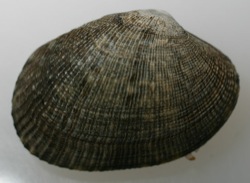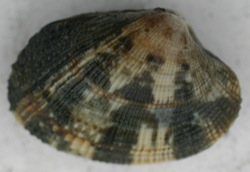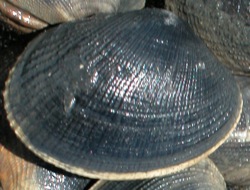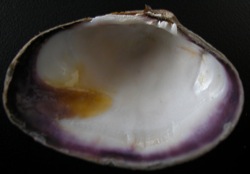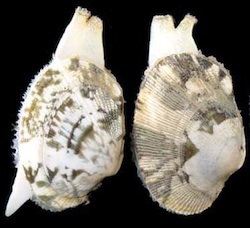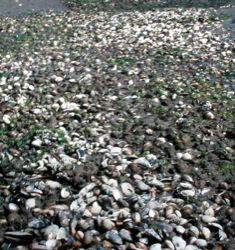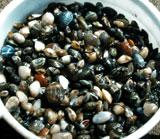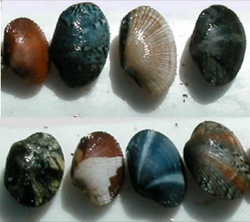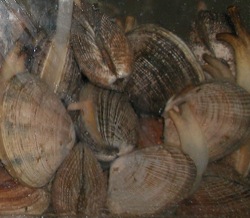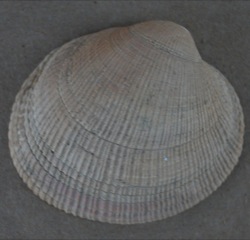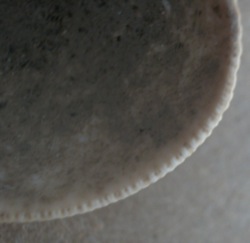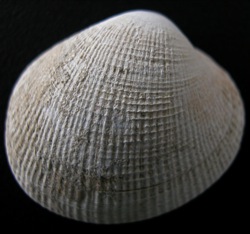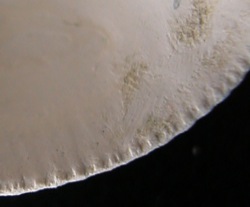Ruditapes philippinarum Image 6
A dense clam bed consisting mainly of
Venerupis philippinarum, in a saltmarsh channel on the east shore of San Francisco Bay.
Return to Top
Ruditapes philippinarum Image 5-siphons
Venerupis philippinarum showing siphons (at top of image) and foot (at lower left). The head end is toward the bottom of the image. Note that the siphons are fused along most of their length, but separated at the tips.
Return to Top
Ruditapes philippinarum Image 4-interior
Venerupis philippinarum from San Francisco Bay showing the interior of the shell, with the head end toward the right. The margins and hind end are deep purple. The rounded, yellow-stained indentation extending in from the hind end marks the pouch that holds the retracted siphons when the shell is closed. There are no teeth along the margin of the shell (compare to
Protothaca, below).
Return to Top
Ruditapes philippinarum Image 3-from black mud
Venerupis philippinarum taken from black, anoxic mud underneath rocks in San Francisco Bay. The head end is toward the right.
Return to Top
Ruditapes philippinarum Image 2 & Key Image-from SFBay#2
Venerupis philippinarum from San Francisco Bay, showing a common color pattern of dark triangular markings. The head end is toward the right.
Return to Top
Ruditapes philippinarum Image 1-from SFBay
Venerupis philippinarum from San Francisco Bay. The head end is toward the right. Note the oval shape, strong radiating ridges, and umbo angled toward the head end.
Return to Top
Venerupis philippinarum Adams & Reeve, 1850
JAPANESE LITTLENECK CLAM, JAPANESE COCKLE, MANILA CLAM
Venerupis philippinarum
has a thick shell, oval in outline, with a maximum length of about 6 cm.
The surface of the shell is sculpted with weak concentric ridges that mark
the shell's progressive growth, and more pronounced straight ridges that
radiate outward from the center of growth to the shell margins. The umbo—the
hump at the center of growth—is at the hinged margin of the shell, about
1/3 of the shell's length away from the head end and angled toward it.
Return to Top
6
Corbula amurensis from San Francisco Bay. with a young barnacle (
Balanus improvisus) attached to the hind part of the shell (lower right part of image).
Return to Top
5
A
Corbula amurensis shell, showing the overbite.
Return to Top
Corbula Key Image
Dried shells of
Corbula amurensis from San Francisco Bay. Note the “overbite” of the larger valve that shows clearly in the clam at the center right.
Return to Top

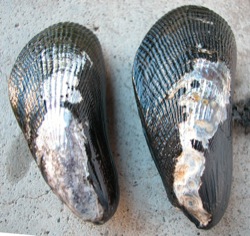 Geukensia demissa
Geukensia demissa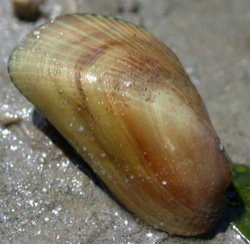 Musculista senhousia
Musculista senhousia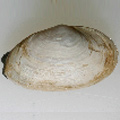 Mya arenaria
Mya arenaria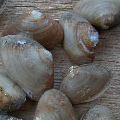 Corbula amurensis
Corbula amurensis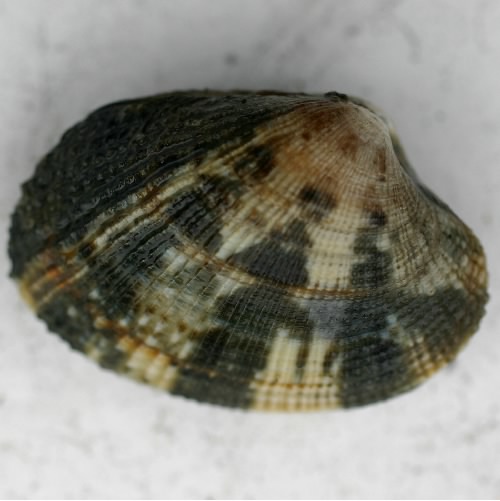 Venerupis philippinarum
Venerupis philippinarum